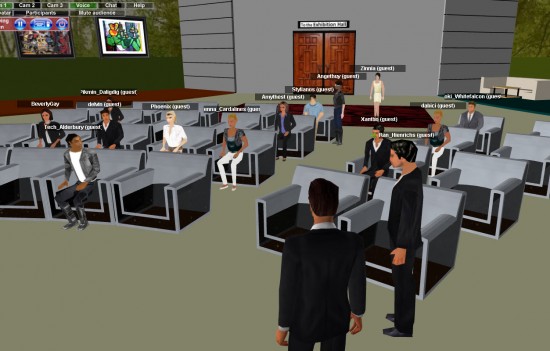Corporations are comfortable with using WebEx-like solutions for their virtual meetings, with some using pseudo-3D platforms for large-scale virtual conferences and trade shows. When they need more sense of presence and more interaction than the typical alternative is face-to-face meetings, even at high transportation costs.
Immersive 3D solutions fill in the gap between the lost cost — but low engagement — of typical online meetings and the high cost and maximum engagement of face-to-face meeting by offering an in-between solution. Companies can save money and time by keeping the meetings virtual, while increasing engagement and interactivity, thanks to 3D immersive, avatar-based platforms.
A virtual conference in 3D
Those who have successfully experienced this alternative, report the following benefits:
- 3D immersive spaces create a sense of presence,
- They feel more like face-to-face meetings than teleconferences
- Avatars lead to more human interactions, more engagement and more networking among attendees
- Avatars and 3D immersion create strong visual memories of meetings
- Importing 3D objects improves communication and collaboration around physical products
This is an ideal solution for corporations as they have the best of both worlds: Virtual meetings save money and time compared to the travel and requirements of face-to-face meetings. Meanwhile, they offer more engagement and interaction than typical online meetings.

Adoption rates
We, at Altadyn, have been in business since 2002. We pioneered browser-based and download-free virtual spaces; 3DXplorer multi-user avatar based platform was introduced two years ago and in-world voice added last year. Now, with thousands of virtual attendees in our platform each week and growing, we are seeing a clear acceleration in usage. We are getting closer to mainstream adoption every month, but some obstacles still remain.
The following are some commonly mentioned issues by corporate users.
Software downloads: Enterprise IT managers are reluctant to allow users to install new software or plugins. It doesn’t matter how small the downloads are — any new installation requires corporate approval, which can discourage employees from trying out new technologies. Browser-based environments help, but many require plugins that can still keep users from attending their meetings.
Enterprise firewalls: Internet browsing only requires port 80 to be open in a corporate firewall. But some virtual meeting platforms require other ports to be opened. This creates significant accessibility issues that need to be addressed.
Bandwidth: Smooth animations and in-world voice often uses up large amounts of bandwidth, which can be an issue in remote offices — where such platforms are most needed.
Support for multiple operating systems and browsers: Although Windows is the dominant platform in corporate environments some 10 percent of enterprise users are running other operating systems. Virtual world platforms that are inaccessible to some fraction of users may be unsuitable for wide-spread enterprise deployment.
User generated content: When corporate users first discover the benefits of an immersive 3D environment, they start to want to replicate their familiar workplaces — their executive briefing center, showrooms, command centers, and so on. The ideal 3D platforms should allow the import of existing 3D models — as well as the ability to embed hyperlinks, documents, video, audio, Twitter feeds and other types of content.
Scalability: Meetings evolve into conferences and customer days evolve into global users group meetings. Corporate users attend meetings that range in size from just a few participants all the way up to thousands. An enterprise-quality 3D meeting platform should be able to handle meetings of different sizes. One way to accomplish this is with cloud-based deployment of pre-configured instances over cloud computing platforms such as Amazon EC2.
Learning curve: Users shouldn’t have to spend too much time in learning how to chat, use voice, sit, use a laser pointer, or share their desktops. Instead, these high-use features should be all be accessible with a single click.
Simple avatars: Long and complex processes to create an avatar are not welcome for most business users. They want to select an avatar quickly and get to their meetings.
Walking and turning: For most business users who have never played a 3D game before, navigating a virtual environment is not intuitive or obvious, even if they’re only require to use the arrow keys. However, without learning how to walk, users will not be able to experience the immersive effects of a 3D environment.
Virtual behavior: Unlike in WebEx and other traditional online meeting platforms, immersive 3D environments allow people to express themselves through gestures, movement and virtual body language. However, in-world gestures — which can create some fun moments and serve as ice-breakers — can also seem silly or unprofessional. That can make a virtual environment feel like a game, not serious enough for corporate use — and that could be fatal to its adoption in the enterprise.
3DXplorer has left most of the above challenges behind, especially those which are technology-related. We are still assisting users in their move towards more sophisticated applications for virtual meetings and working with them on better setting their expectations.
(This article adapted with permission from the 3DXplorer blog.)
- Ten Challenges 3D Virtual Meeting Platforms Face in Corporations - March 7, 2011
- Why should virtual events look like in-person events? - February 3, 2011
